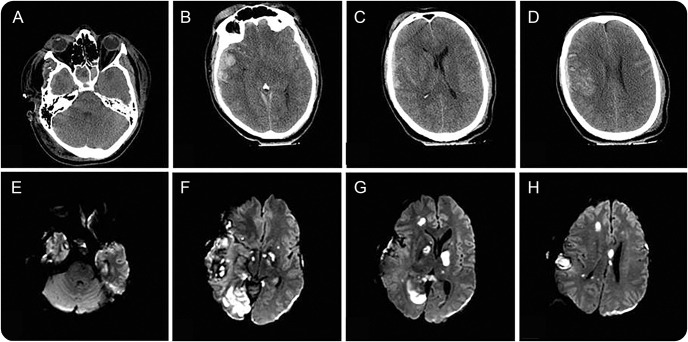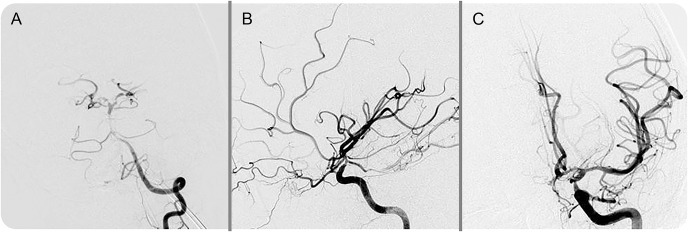A 45-year-old man had a severe traumatic brain injury (TBI) with multicompartmental hemorrhages (figure 1). He was initially noted to be awake and following commands with his right side. Two weeks later, his examination deteriorated to coma with flaccid quadriplegia. Initial workup, including EEG, was unrevealing. MRI brain showed new multiterritorial infarcts (figure 1); a catheter-based angiogram confirmed severe vasospasm in several large vessels (figure 2).
Figure 1. CT head and MRI brain.
Admission head CT shows right temporal contusion (B–C) with bilateral subarachnoid hemorrhage (B–D). Axial diffusion-weighted imaging 2 weeks later shows new infarcts in the right frontal lobe (G and H), bilateral deep nuclei and splenium of the corpus callosum (G), and right occipital lobe (F and G), while sparing the brainstem (E); prior right temporal contusion, subdural and subarachnoid hemorrhages, and areas of axonal injury are also noted.
Figure 2. Cerebral angiogram.
Catheter-based angiogram shows severe vasospasm of the basilar (A), bilateral posterior cerebral (A), right internal carotid (B), and left internal carotid arteries (C).
Vasospasm following TBI has been previously described as underrecognized because it is often clinically silent, and typically occurring in the first several days when symptomatic.1,2 Late and extreme cases, as above, are rarely described.
Supplementary Material
Footnotes
Download teaching slides: Neurology.org
AUTHOR CONTRIBUTIONS
Dr. Reznik: study design, analysis/interpretation of the data, drafting/revising the manuscript. Dr. Saeed: analysis/interpretation of the data, revising the manuscript. Dr. Shutter: study design, analysis/interpretation of the data.
STUDY FUNDING
No targeted funding reported.
DISCLOSURE
The authors report no disclosures relevant to the manuscript. Go to Neurology.org for full disclosures.
REFERENCES
- 1.Oertel M, Boscardin WJ, Obrist WD, et al. Posttraumatic vasospasm: the epidemiology, severity, and time course of an underestimated phenomenon: a prospective study performed in 299 patients. J Neurosurg 2005;103:812–824. [DOI] [PubMed] [Google Scholar]
- 2.Kramer DR, Winer JL, Pease BA, Amar AP, Mack WJ. Cerebral vasospasm in traumatic brain injury. Neurol Res Int 2013;2013:415813. [DOI] [PMC free article] [PubMed] [Google Scholar]
Associated Data
This section collects any data citations, data availability statements, or supplementary materials included in this article.




